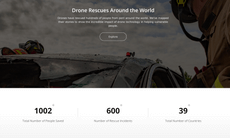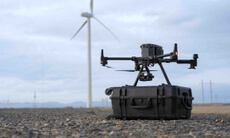DJI Encourages Customers To Embrace New EU Drone Regulation
The Harmonized Framework Will Bring Streamlined Processes Across Most Of Europe
New European Drone Regulation as laid out by the European Union Aviation Safety Agency (EASA), will come into effect on 31 December 2020 and be applicable in all EU member states, Norway, Iceland, and Liechtenstein as well as the UK. These new rules offer, for the first time, a harmonized framework across most European countries and will help drone pilots to operate their drones in different territories on the same conditions as in their home country regardless of recreational or commercial purposes. This will effectively improve flight safety, simplify user approval procedures, facilitate users' personal and business applications, enhance user experience, and support rapid business development.
“We welcome the new EU Drone Regulation as it streamlines different processes and allows DJI customers to travel from country to country without having to worry about different rules in different foreign locations,” says Christian Struwe, Director of Public Policy at DJI EMEA. “Striking a balance between the need to harmonize regulation of the safe use of drone technology and allowing our customers to benefit freely from its growing potential has always been of paramount importance for DJI in Europe.”
The new regulation distinguishes between low-, medium- and high-risk categories with different requirements for products and operators. The most widely used category will be the Open Category (low risk) which will be managed through the so-called CE (Conformité Européenne/European Conformity) marking process which is an established process for products sold in Europe to ensure they meet safety, health and environmental protection requirements. In addition to already existing CE marking, the new CE class identification labels for drones will define, amongst others, which types of drones (categorized by weight), can be flown in which type of environment (over people - A1 environment, near people - A2 environment or away from people - A3 environment).
For a transition period of two years, until 1 January 2023, DJI customers with drones bought before 1 January 2021 which do not have a CE class identification label can fly in the so-called Open Limited Category with very little or any disadvantage - where the following rules apply:
|
|
Weight[1] |
DJI Drone Type |
Max flight height |
Flight over people |
Minimum age of pilot |
Need for insurance |
Registration |
Knowledge test |
|
A1 |
< 250g |
Mavic Mini, DJI Mini 2
|
120m |
Over individuals but not crowds |
Depends on country |
Depends on country |
Yes |
Yes, but which one depends on country |
|
250g - 499g |
Mavic Air, Spark |
120m |
Not over uninvolved[2] people or crowds |
Depends on country |
Depends on country |
Yes |
Yes, but which one depends on country |
|
|
A2 |
500g -< 2kg |
DJI Air 2S, Mavic Pro, Mavic 2, Mavic Air 2, Phantom series |
120m |
Minimum distance of 50m |
Depends on country |
Depends on country |
Yes |
Yes, but which one depends on country |
|
A3 |
500g-< 2kg |
DJI Air 2S, Mavic Pro, Mavic 2, Mavic Air 2, Phantom series |
120m |
Minimum distance of 150m |
Depends on country |
Depends on country |
Yes |
Yes, but which one depends on country |
|
2kg -<25kg |
Inspire and Matrice series |
120m |
Minimum distance of 150m |
Depends on country |
Depends on country |
Yes |
Yes, but which one depends on country |
From 1 January 2023 DJI drones without CE class identification labels can only be operated in the Open Limited Category A1 (if they weigh below 250g) or A3 (between 250g and 25kg) and in the Specific Category.
For customers who buy DJI drones with CE class identification labels once they are available from 1 January 2021, rules that apply can be found here.[3]
While the framework comes into effect on 31 December 2020, some countries will be slower to fully implement the rules than others. Therefore, it is important that drone operators check with their local authorities for details.
For more information please consult your national regulator or visit EASA’s drone pages https://www.easa.europa.eu/domains/civil-drones-rpas
[1] For a comprehensive list of drone weights, please refer to the product pages on www.dji.com/id
[2] A person who is not participating in the drone operation or who is not aware of the instructions and safety precautions given by the drone operator
[3] The details of new CE class identification standards are still being determined, and DJI is actively working with authorities and notified bodies on deciding which DJI drone models will be able to receive new CE class identification labels. Once the standards have been set (date TBC), DJI will inform customers which DJI products will qualify to receive them.


